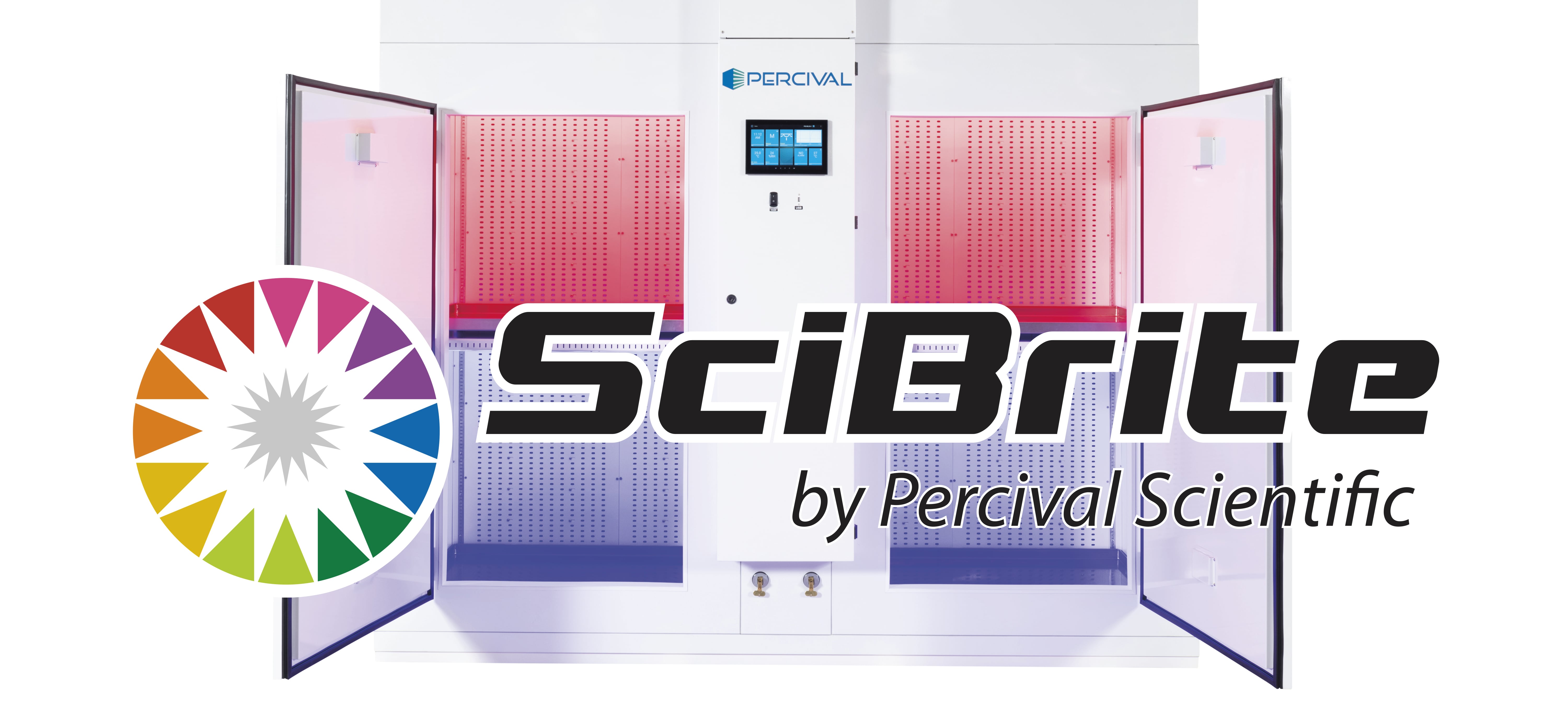SciBrite

SciBriteTM LED lighting gives you the most extensive range of color
spectrums available for your research. Not only that, our proprietary colored LED system uses a first-of-its-kind engineered design that produces evenly mixed colors ratios and unmatched lighting uniformity. This lighting is dimmable and allows you to control the intensities for each color to create specific light wavelengths for your experiments with plants, insects or any research that requires specific spectrums. And, using our touchscreen control system, programming your SciBrite LEDs is quick and easy.
Available in four-color or eight-color configurations, our groundbreaking colored LED lighting gives you the most control over your research.
SciBrite Lighting Performance Is Tested and Proven
Unparalleled Uniformity
Percival Scientific’s SciBrite LEDs achieve consistent lighting uniformity across all regions of the
PAR spectrum at measured levels never seen before. Our engineers applied high-level testing to
reach an impressively low global relative standard deviation of light uniformity across all
colors.*
*The coefficient of variation of the light intensity is less than 0.08 at 15 cm and 0.05 at 30 cm in our 41 standard series chambers.
Evenly Mixed Colors
When measured with proper scopes, SciBrite LEDs show evenly mixed color ratios, ensuring consistent plant growth inside our growth chambers.
Superior Spectral Control and Low Heat Emission
SciBrite lighting can be configured with up to eight colors, allowing you to create nearly any spectrum your research requires. Each color is independently dimmable in one-percent increments for precise control over specific wavelengths, making them ideal for a wide range of scientific applications. SciBrite LEDs also emit very little heat.
Energy-Efficient LED Bulbs
Percival Scientific’s proprietary SciBrite LED lighting system is backed by years of research and development. These high-intensity LED lights are more energy-efficient than previous Percival LED lighting technology and are long-lasting and cost-effective.
SciBrite LEDs are an ideal light source for controlled environments because they introduce considerably less heat into the experiment space than alternative lighting systems.
- Less demand on the temperature control system
- Improved humidity control
- Improved temperature uniformity
- Smaller day/night calibration offsets
- Reduced energy
- Lower heat rejection to ambient
- Improved system responsiveness
- Increased lifespan of vital chamber components
Innovative Lighting Control
Percival’s SciBrite LED lighting system offers a wide variety of color combinations. Choose from a standard four- or seven-color configuration, or create your own custom color mix by consulting with our knowledgeable staff. Each color is independently dimmable in one-percent increments.
The SciBrite LED system helps you create better science by giving you more control over the composition and intensity of each color, according to the specific requirements of your research. SciBrite LEDs give you the ability to select and control specific light wavelengths, making them ideal for a wide range of scientific applications.
Advanced IntellusUltra Control System
Unlock the full potential of your SciBrite LED system with a wide range of control system upgrades, including:
- IntellusUltra Connect for web-based remote user interface and data acquisition
- C9T touchscreen user interface for intuitive control and programming screens; graphical performance data; and colorful, visual notifications
- WeatherEze for global weather simulation, including precise qualitative and quantitative replication for sunlight conditions throughout the SciBrite lighting system
SciBrite LEDs
You can choose a standard four-color or eight-color lighting system configured with any combination of our available colors.

Standard Four-Color Configuration
(Cool White, Red, Blue, Far-Red)

Eight-Color Configuration
(Cool White, Blue, Green, Red, Deep Red, Far-Red, Violet, Warm White)
See All Four-Color Measurements
| Units | Specifications |
|---|---|
| Voltage (V) | 48.2 |
| Amperage (A) | 1.25 |
| Wattage (W) | 60.25 |
| PAR Efficacy (µmol/J) | 1.69 |
| PFD (380-780 nm) | 121.2 |
| PPFD (400-700 nm) | 102 |
| PFD-UV (380-400 nm) | 0.3084 |
| PPFD-B (400-500 nm) | 49.5 |
| PPFD-G (500-600 nm) | 11.55 |
| PPFD-R (600-700 nm) | 41.1 |
| PFD-FR (700-780 nm) | 19.11 |
| CIE1931-x (all in µmol/m^2/s) | 0.2321 |
| CIE1931-y (all in µmol/m^2/s) | 0.1121 |
See All Eight-Color Measurements
| Units | Specifications |
|---|---|
| Voltage (V) | 48.2 |
| Amperage (A) | 1.8 |
| Wattage (W) | 86.76 |
| PAR Efficacy (µmol/J) | 2.28 |
| PFD (380-780 nm) | 223.2 |
| PPFD (400-700 nm) | 197.6 |
| PFD-UV (380-400 nm) | 0.301 |
| PPFD-B (400-500 nm) | 57.08 |
| PPFD-G (500-600 nm) | 49.95 |
| PPFD-R (600-700 nm) | 91.37 |
| PFD-FR (700-780 nm) | 25.54 |
| CIE1931-x (all in µmol/m^2/s) | 0.3137 |
| CIE1931-y (all in µmol/m^2/s) | 0.2416 |
Available Colors
Select a color below to view its spectral graph.




